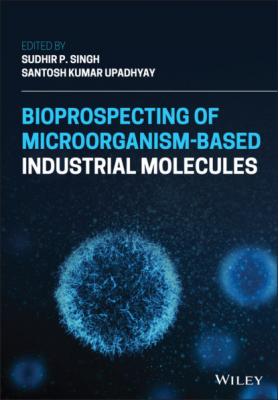Bioprospecting of Microorganism-Based Industrial Molecules. Группа авторов
Читать онлайн.| Название | Bioprospecting of Microorganism-Based Industrial Molecules |
|---|---|
| Автор произведения | Группа авторов |
| Жанр | Биология |
| Серия | |
| Издательство | Биология |
| Год выпуска | 0 |
| isbn | 9781119717263 |
In an attempt to solve relevant drawbacks related to low biodegradability profiles of synthetic surfactants, pollution of traditional chemical processes, and sacrifice of natural resources, new sustainable approaches have recently emerged, implying biotechnological means for surfactant obtention. In this context, BS are known to be secondary metabolites of living organisms just as bacteria and yeast and to be involved in some microbial physiological functions, e.g. cell development, biofilm formation, and osmotic pressure regulation. Furthermore, these play a key role in microbial survival in front of adverse situations such as lack of nutrients and the need to incorporate non‐soluble substances like hydrocarbons as the only carbon source [2]. These natural phenomena have been exploited by bioengineering in productive microbial fermentation, and since BS are achieved through complex enzymatic reactions, such biomolecules are endowed of robust chemical architectures, which are tunable from elegant processes of molecular biology, genetic engineering, or careful selection of culture conditions.
In the second category, surfactants are normally grouped according to the presence or absence of formal electrostatic charges in the hydrophilic moiety of the molecule. Thus, cationic surfactants contain formal positive charges (+) on the polar head of the surfactant molecule and are systematically escorted by negative counterions that neutralize the charges. Anionic surfactants have negative formal charges (−), an example of this latter is represented in Figure 2.1. The third class of ionic surfactants is those species comprising both positive and negative charges in the same body (±). These species are known as inner salts or zwitterions (from German zwitter = hybrid). The last case of this classification is the absence of formal charges in the surfactant molecule, so these are called nonionic surfactants.
Figure 2.1 3D chemical structure of lauryl sulfate as an example of a surfactant molecule. The hydrophilic head of sulfate (SO42−) is surrounded by water molecules, while the lipophilic tail avoids any contact with water.
Source: Based on [1].
Table 2.1 Classification of surfactants by origin, ionic status, and hydrophilic–lipophilic balance.
| Category | Example | ||
|---|---|---|---|
| I. Origin | Synthetic | Nonylphenol ethoxylates | |
| Oleochemical | Lauryl alcohol ethoxylates | ||
| Biosurfactants | Sophorolipids | ||
| II. Electrostatic status | Oonic | Cationic | Ammonium salts |
| Anionic | Lauryl sulfates | ||
| Zwitterionic | Betaines | ||
| Nonionic | Oxirane and 2‐methyoxirane copolymers | ||
| III. Hydrophilic–lipophilic balance | 01–03 | Antifoaming agents | |
| 03–08 | w/o emulsifiers | ||
| 07–10 | Wetting agents | ||
| 08–16 | o/w emulsifiers | ||
| 13–16 | Detergents | ||
| 16–19 | Solubilizing agent | ||
Finally, surfactants can be ranked according to their amphiphilic nature, otherwise by their hydrophilic–lipophilic balance (HLB). Although there are a significant number of theoretical and experimental approaches, the most used HLB system is the Griffin’s [3]. In a simplistic way, HLB values are estimated from the division of the mass of the hydrophilic fragment by the mass of the entire molecule, and the resulting quotient is then multiplied by a conventional value of 20. HLB can predict whether a surfactant will behave as an emulsifier, solubilizer, dispersant, or other; therefore, this system has been a useful guide to formulate products containing conventional surfactants for specific applications, and certainly, will be just as convenient for the case of BS. The hydrophilic part of BS is normally constituted by carbohydrates, amino acids, proteins, phosphates, carboxylic acids, or alcohol motifs; and these can be ionic or nonionic. The lipophilic part commonly is long chains of carbon atoms, just as in fatty acids. Both molecular components, hydrophilic and lipophilic, are assembled via linking biochemical functionalities, e.g. ethers (C−O−C), amides (N−C=O), and esters (O−C=O). According to the nature of each moiety hydrophilic and lipophilic, BS are commonly classified in the following groups: (i) glycolipids, (ii) lipopolysaccharides, (iii) lipopeptides, (iv) phospholipids, and (v) fatty acids; each one with specific physicochemical characteristics and physiological roles [4, 5]; for example, Emulsan and other complex lipopolysaccharides are polymeric BS with known emulsification capabilities.
From all the types of BS, glycolipids have the greatest opportunity to be manufactured on a large scale due to the high yield of obtention compared to other BS such as lipoproteins. It is clear that BS produced in higher yields will represent a lower cost for production [6]. This is why glycolipids have captured our attention for this chapter. Glycolipids result from the condensation of aliphatic fatty acids (lipids) and carbohydrates. Their names are taken from the nature of the carbohydrate moiety. Consequently, glycolipids containing sophorose in the hydrophilic segment are called sophorolipids (SL); those containing rhamnose are named rhamnolipids; those with trehalose, trehalose‐lipids, and so on. Of all the glycolipid types, SL and rhamnolipids have been among the most studied [7, 8].
SL (Figure 2.2) contain the disaccharide sophorose linked to a fatty acid via an ether function. The fatty acid must be previously hydroxylated somewhere in the carbon chain, usually at the other end of the carboxylic acid function. SL can be found as different chemical structures. The most evident and well known is the divergence between open and cyclic arrangements [9]. Open SL are those that have the chemical functionality of carboxylic acid (COOH) at the end of the lipophilic chain, while cyclic arrangements are those having an ester functionality as a result of the condensation between the fatty acid and one of the hydroxyl motifs of the sophorose.
